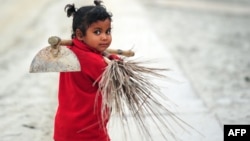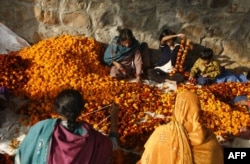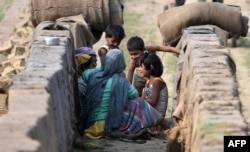In India, child rights activists and the United Nations Children's Fund have expressed concern about a controversial new child labor law they fear will make young boys and girls more vulnerable to exploitation.
The new measure sets out to tighten an existing law by imposing a blanket ban on employment of those under 14 for the first time.
Loophole: family enterprises
But critics worry about an exception that permits children to work in family-based enterprises after school hours and during holidays. The sweeping definition has a catch: the extended family, including distant relatives, comes under the ambit of family enterprises.
Activist Kailash Satyarathi, who has won the Nobel Peace Prize for his work in combating child labor, says this “loophole” will make it tough to enforce the ban and push open the door for many young children to be put to work.
“I have rescued thousands of children whose employers were claiming to be uncles, aunts, maternal uncles, etc. It was very difficult to rescue those children,” he said. “There is no way to monitor it. Nobody is going to take the DNA test of every single so-called family member to establish whether they had blood relations or whatever.”
Children helping parents
Activists say the exception made for family enterprises would also give small manufacturers an incentive to push production into homes in a country where millions of young boys and girls toil in farms and small manufacturing units, in tea shops and restaurants, and work as domestics in middle class homes.
Bidisha Pillai, advocacy director at Save the Children, points to a recent study done in Delhi’s garment industry that showed 15,000 children helping parents embellish garments with sequins or embroidery at home.
“Typically that does not happen in the factory, that is outsourced into the homes, people are paid on a piece rate basis. So obviously the more number of people family can produce at the end of the day, they will earn more money,” said Pillai.
The government’s argument is that this provision will allow children to learn family trades. Others say it takes into account India’s economic reality in which poor parents rely on children to supplement meager incomes in some way.
UNICEF has urged its removal, saying it not only legitimizes family work, but it also could further disadvantage the most vulnerable children from poor families.
Estimates on the number of child laborers in India vary hugely, with the International Labor Organization saying about 5.7 million children in the country work for wages and another six million in family trades.
There are some pluses in the new law. It has imposed tougher penalties for violators by doubling jail terms to two years and increasing fines from $300 to about $740.
It also imposes a first-time prohibition on children between 14 and 17 working in hazardous industries. But here too there is a catch: the list of such industries has been reduced from 83 to just three.
Taken together with the relaxation on family based enterprises, Satyarathi feels it is a huge step back. “If you mix these two lacunae, children could be allowed to work in brick kiln, glass furnaces, slaughter houses and so many other places which are hazardous for any children,” he said.
While Satyarathi and other activists say they will continue to fight for a tougher law, they stress that the need of the hour is also to use other tools to end child labor in a country where poverty is often cited as a justification for employing young children. “Law is not the end of the road, there are so many ways, mobilizing the masses, also creating much more consciousness and awareness in society,” he said.










